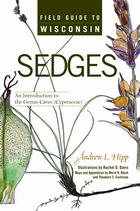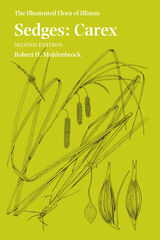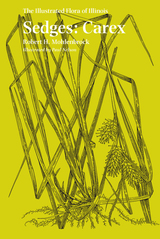4 books about Carex

Carex of Illinois and Surrounding States
The Oval Sedges
Michael Murphy, Greg Spyreas, and Paul Marcum
University of Illinois Press, 2024
A common group of plants in the Midwest’s natural areas, the oval sedges supply food for wildlife while their roots bind the soil and their vegetation creates habitat. Carex of Illinois and Surrounding States: The Oval Sedges offers a guide to the identification, distribution, and natural history of this diverse group of plants. Focused on the Carex section Cyperoideae, the editors cover Illinois’ twenty-five species, every oval sedge in Indiana and Kentucky, and nearly every species in Iowa, Michigan, Missouri, and Wisconsin. A two-step process helps users recognize the notoriously difficult-to-identify plants while illustrations and labeled photographs aid users in evaluating morphological characteristics. The editors also furnish first-ever distribution maps for Illinois’ recently described species and varieties plus up-to-date maps for nearly every other species.
Drawing on the study of thousands of specimens, Carex of Illinois and Surrounding States: The Oval Sedges is an invaluable resource for botanists, ecologists, environmental engineers, and professional and amateur environmentalists interested in a deeper understanding of these essential plants.
[more]

Field Guide to Wisconsin Sedges
An Introduction to the Genus Carex (Cyperaceae)
Andrew L. Hipp; Illustrations by Rachel D. Davis; Maps and Appendices by Merel R. Black and Theodore S. Cochrane
University of Wisconsin Press, 2008
Sedges are among the world’s most diverse and ecologically important plant families, with almost two hundred species in Wisconsin alone. These grass-like plants, found mostly in wetlands, are increasingly popular with landscapers and home gardeners. Learning to identify sedges is challenging, however, and the available technical guides to the sedge family can be overwhelming to a nonspecialist. Field Guide to Wisconsin Sedges is a beautifully illustrated introduction to the largest sedge genus, Carex, which alone makes up about 7 percent of the flora of the upper Midwest.
Written primarily for naturalists, wild plant enthusiasts, and native landscapers, this book is unique in its accessible format and illustrations. With this book, readers can learn to recognize key structures needed to identify approximately 150 Carex species found in Wisconsin. Author Andrew Hipp shows how to identify many of the major groupings of sedges that are used in guides to the genus throughout the world.
Field Guide to Wisconsin Sedges includes information on habitat and range drawn from Hipp’s extensive field experience and inspection of thousands of herbarium sheets. Primarily an identification guide, the book is also a valuable source of habitat information for landscapers, gardeners, and restorationists.
Features:
• Keys to all Wisconsin Carex species, arranged by section
• Distribution maps for all species
• Species descriptions and detailed habitat information for more than 50 common species
• Color illustrations of whole plants or details for more than 70 species
• Appendix summarizing dominant Carex species by Wisconsin habitat
• A glossary of terms
• Water-resistant paperback cover
[more]

Sedges
Carex
Robert H. Mohlenbrock
Southern Illinois University Press, 2011
Sedges: Carex is the fourteenth volume of the Illustrated Flora of Illinois series and the sixth and last volume devoted to monocots—plants that have a single seed leaf, or cotyledon, upon germination.
Since the volume’s original publication in 1999, thirty-four additional species of plants have been recognized in Illinois. Some are discoveries from recent field work, some are from more thorough searches of herbaria, and others are from different taxonomic philosophies.
For each species of Carex in Illinois, there is a full illustration showing the habit of the plant and close-ups of various vegetative and reproductive structures that are crucial for the identification of the individual species. There is also a complete description of each species as well as a detailed discussion of the nomenclature and habitats. Range maps show the county distribution of each species in Illinois. A new and detailed key is provided for identification of the species.
Since the volume’s original publication in 1999, thirty-four additional species of plants have been recognized in Illinois. Some are discoveries from recent field work, some are from more thorough searches of herbaria, and others are from different taxonomic philosophies.
For each species of Carex in Illinois, there is a full illustration showing the habit of the plant and close-ups of various vegetative and reproductive structures that are crucial for the identification of the individual species. There is also a complete description of each species as well as a detailed discussion of the nomenclature and habitats. Range maps show the county distribution of each species in Illinois. A new and detailed key is provided for identification of the species.
[more]

Sedges
Carex
Robert H. Mohlenbrock. Illustrated by Paul Nelson
Southern Illinois University Press, 1999
Sedges: Carex is the fourteenth volume of the Illustrated Flora of Illinois series and the sixth and last volume devoted to monocots, or plants that have a single seed-leaf, or cotyledon, upon germination. For each of the 159 species of Carex in Illinois, there is a full illustration showing the habit of the plant and close-ups of various vegetative and reproductive structures that are crucial for the identification of the individual species. There is also a complete description of each species as well as a discussion of the nomenclature and habitats. Range maps show the county distribution of each species in Illinois. A detailed key is provided for identification of the species.
Unique in several respects, Carex is by far the most numerous genus of plants in Illinois. Because of the vast number of species, the similarity of many of the species, and the relatively small size of the critical reproductive structures, the members of this genus are extremely confusing to identify. This book, with its detailed descriptions, key, and precise illustrations, should aid the interested person in the identification of these plants.
Since more than three-fourths of the species of Carex in Illinois are inhabitants of wetlands, an understanding of the genus is critical for those working in wetlands. Amateur and professional botanists will find the information extremely valuable, as well as environmental and conservation groups, garden clubs, farm bureaus, home extension groups, scout organizations, and school libraries. Persons working in natural areas programs and in rare and endangered species programs and those working on environmental impact assessments and wildlife management projects will also find the information pertinent.
Unique in several respects, Carex is by far the most numerous genus of plants in Illinois. Because of the vast number of species, the similarity of many of the species, and the relatively small size of the critical reproductive structures, the members of this genus are extremely confusing to identify. This book, with its detailed descriptions, key, and precise illustrations, should aid the interested person in the identification of these plants.
Since more than three-fourths of the species of Carex in Illinois are inhabitants of wetlands, an understanding of the genus is critical for those working in wetlands. Amateur and professional botanists will find the information extremely valuable, as well as environmental and conservation groups, garden clubs, farm bureaus, home extension groups, scout organizations, and school libraries. Persons working in natural areas programs and in rare and endangered species programs and those working on environmental impact assessments and wildlife management projects will also find the information pertinent.
[more]
READERS
Browse our collection.
PUBLISHERS
See BiblioVault's publisher services.
STUDENT SERVICES
Files for college accessibility offices.
UChicago Accessibility Resources
home | accessibility | search | about | contact us
BiblioVault ® 2001 - 2024
The University of Chicago Press









